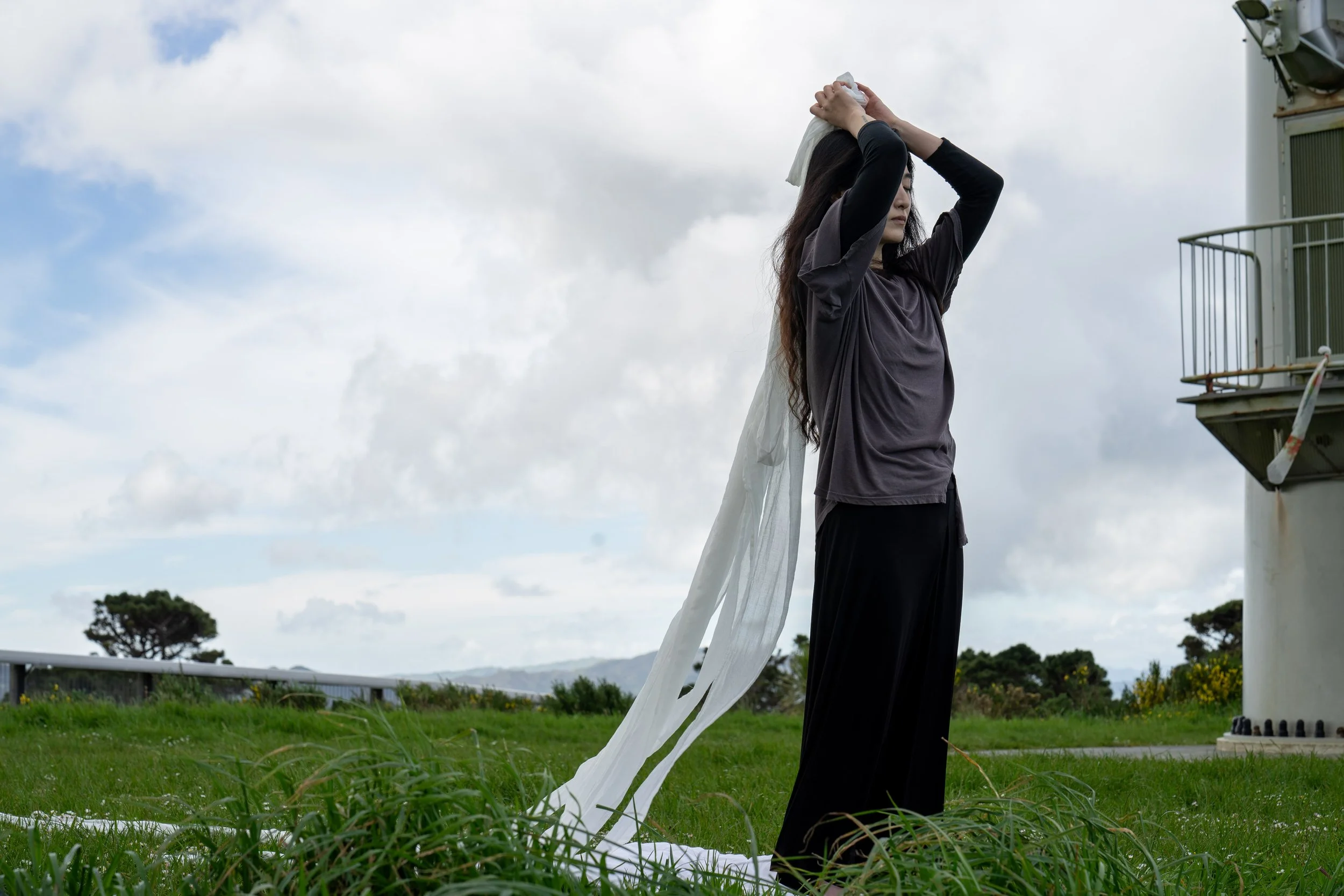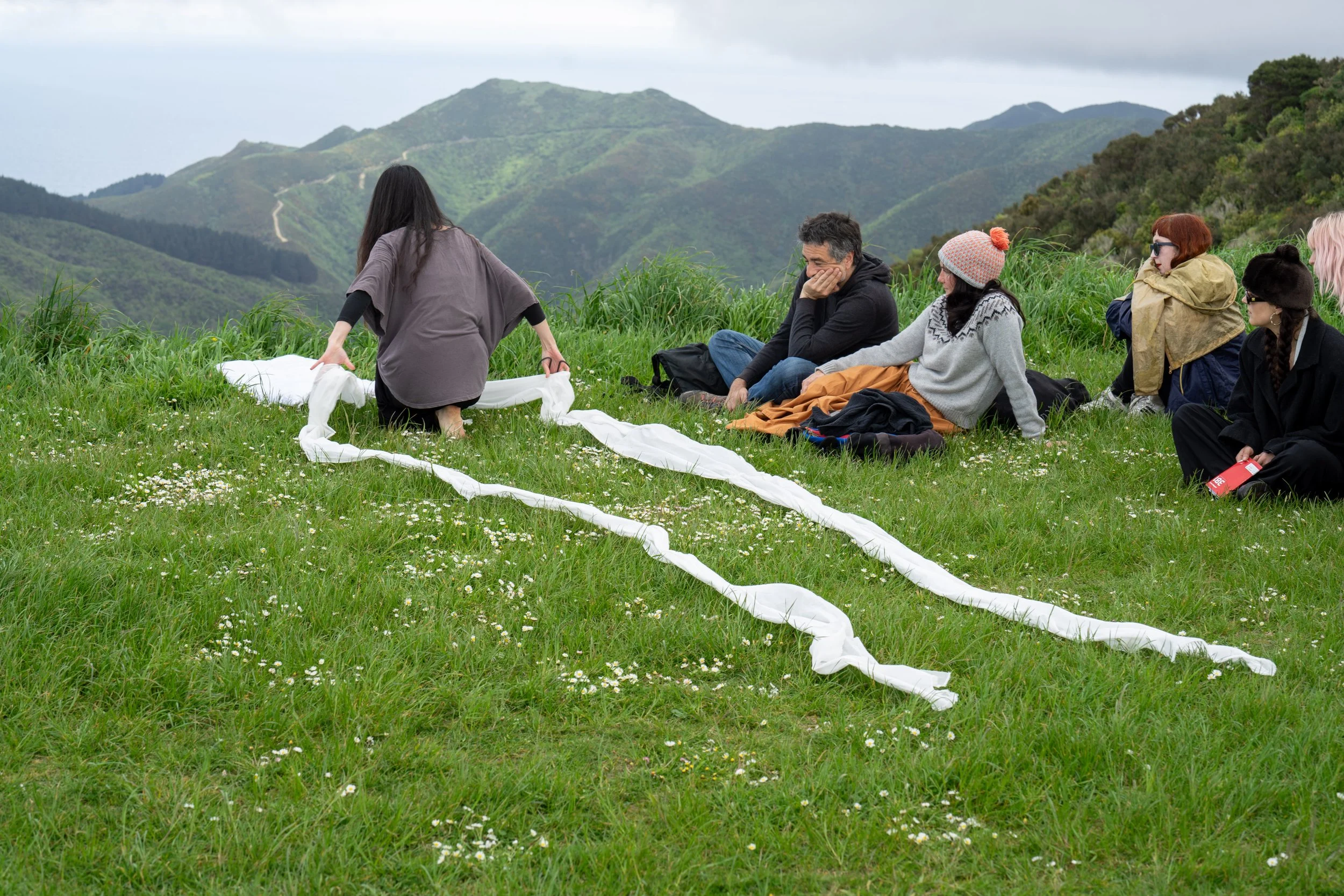PAWA 2023: Pieces of the Island (Part Two)
This article is published in collaboration with Performance Art Week Aotearoa 2023. Showcasing performance artists from across Aotearoa and the world, Performance Art Week Aotearoa brings a stellar line-up of performance art works, workshops, discussion and happenings to Wellington city. Rat World is excited to platform a range of critical writing on the events from the year’s festival.
Photos by Robyn Jordaan
Artist EunSun Heo’s work, Pieces of the island (part 1 and 2), invokes the audience to think of the ways in which islands are divided, and how they divide us. Like the islands, we, as its people, are pushed and pulled apart from one another. Our lives are spent endlessly trying to close the distance and create a unified whole, like Maui sinking his hook into Te Hiki from Te Waka and hauling it to the surface to form Aotearoa.
However, as EunSun shows us, our spaces never quite allow the closure we long for.
Our roles on this earth are simply as vessels for the Wind, an agent of chaos that tosses us around and turns us about until we’re confused on where our individual journeys begin and end. Our purpose, through our actions and our words, become fractured by the ceaseless randomness of life, invoking us to draw imaginary borders in the pure illusion of safety and comfort.
As I hiked up to the Brooklyn Wind Turbine on a Sunday afternoon for part 2 of EunSun’s performance, I prepared my defences for battle. Põneke had decided to put on its Sunday best, showing off its almighty power to locals and visitors alike. As the windiest place in the entire city, it was only practical that you surrender to the natural order of the space and hope it’ll whip you towards your eventual destination. Surrounded by an ominous overcast only too characteristic of our moody city, the towering turbine took up the staring role of Hades. Each of his blades spun with monotonous anticipation of his judgement, slowly passing over our heads with a force that suggested he was still pondering who would be spared and who would be thrown into the sea.
What I was most surprised to find, however, was that we actually seemed to be in the eye of the storm, rather than the storm itself. The entire space felt like something of an in-between - the Gates of the Underworld rather than the Underworld itself. The turbine appeared to be directing the winds, EunSun’s performative partner, around our idyllic patch of grass and shielding us from its full wrath. With this realisation, the turbines threatening whooshes of judgement shifted into the sweet breezes you’d find at the tops of trees. Gentle, soothing, lulling us to sit and observe its power over our destinies. For a few mere hours, it was as though the chaos of the world that festers beyond our temporary space became muted.
As I arrived a few minutes prior to the performance’s start time, wrapped up in my warmest winter clothes and jogging on the spot out of coldness and existential angst, I noticed EunSun lying peacefully on the grass beneath the turbines. She was dressed in a plain black t-shirt and black linen pants that seemed to flutter as part of the wind’s orchestra. At first glance, it was as though she had been lying in that exact spot her entire life, waiting for her performative partner to finally call upon her and share their message with the world. As we grazed past three o’clock with very little commotion, I watched EunSun slowly rise and float towards the gated stairs situated at the bottom of the turbine. A small bell, looped around her ankle, seemed to signal her acceptance of the message from the spirits, and the authoritative whooshing of the turbine blades grew louder in beckoning for our own voices to grow silent.
I found a spot of grass separate from those around me, and bore witness to the message.
Her bell tinkled with each slow step up the turbine’s metal stairs, finding her place on the platform situated in the eye of winds forming around her. Her minimal tools for her performance were gathered - a sewing needle, a white cloth, a bare white cushion, and herself. She begins by slowly and carefully stitching the cloth back to an edge of the cushion, its tattered ends peaking through the metal grates and flapping madly in the wind like a white flag. Each of EunSun’s movement appear devoid from trying to reach finality, each stitch made without any overt indication of intentionality or precedence. They were simply happening as though guided by a greater, invisible hand.
With one final stitch, EunSun lifted her finished flag into the air and faced off with Te Moana-o-Raukawa and Te Waka a Māui. The wind ripples its thin material in each and every direction, as though confused by its own purpose. I close my eyes as the rhythmic toll of the blades seem to chime in remembrance for something that had been lost.
EunSun believes that her work is only complete when there is a connection between the performance and the audience’s behaviour and reaction. In the freedom of space and time that the performance had given us, I wondered what it was that had been lost, and who the white flag could be for. I searched around and slowly took in the conflict of space in which we were located. Between two islands separated by sea, between each other separated by division. It dawned on me that we were like islands ourselves, mourning the loss of our once unified whole of many millennia past. The white flag has become our symbol for peace and new connection. It begs the winds to help piece our fragmented parts back together.
As though directed by the breeze, my thoughts then couldn’t help but drift towards Palestine and the recent attacks on the Gaza strip. All around the world I could see and hear calls for a ceasefire through my phone, and yet I felt entirely helpless watching Palestinians be imprisoned within borders imposed by those not from their land. I look within myself and seem only to find a cavern of infinite grief. Grief for the lives that have been lost. Grief for the lives that will be lost. Grief for the destruction of an entire people. Grief for the generational trauma caused by settler colonialism. Grief for our inability to do anything but witness their suffering and feel their pain become intertwined with each and every breath of our remaining humanity. Grief that we have arrived at a point in human history where it is normal to feel paralysed by reality.
I envision myself out on the Strait. I’m paddling towards an island in which everything that’s been lost, memories as fresh and pure as the sea salt on my tongue, will be waiting patiently beyond the shore. But the island is being destroyed by vicious military forces, and I’m left stranded between a yearning for what must be forgotten in the past, and a pain that will forever live in tomorrow.
As I’m drawn back to my patch of grass, I let the wind carry these emotions into our floating present, the collective sadness of our entire history feebly searching for a resting place among the hills that EunSun faces her flag towards.
The finished flag is then laid like a blanket over an audience member resting by the edge of the mountain, unsure whether to move or simply become a part of the piece. They choose the latter, closing their eyes and facing up to the sky, decidedly content with this unexpected gesture of comfort. I’m reminded of part 1, in which EunSun moved around the circle of spectators outside of Adams Art Gallery and used the same flag to enwrap people in hugs. Warm, gentle hugs. Hugs that make it feel as though human touch is the only way our grief could be patched together into a fragile whole. Hugs so desperate and fleeting that for a moment, our physical connection to one another feels like it’s enough. It has to be enough.
Two separated bodies bordered by skin and flesh become one. What is lost is suddenly found again. The wind that tears us apart grows peaceful in slumber.
But I lingered in the delicacy of restoration for too long. Like a lightning strike to the spine, EunSun tears us apart once more. The cloth, still lying over the audience member, is ripped horizontally with a simplicity that feels criminal. All those soft stitches of reparation, the symbol of our white flag for peace, the blanket of warmth and renewed connectivity, are destroyed in just a few haphazard movements. We are strewn apart once more. The wind wakes up, as though irritated at being disturbed, and whips around the fragmented flag to boast of its uncontrolled and unfeeling disposition to our earthly desires. EunSun carries the remains of the flag in each direction, held high over her head, as though wondering when the answer to our calls would return again.
The blades continue their same monotonous harmony. The wind continues its howl. EunSun stands back on the metal steps below the turbine and bows, her call from the divine guide ceasing for the time being.
And there we remain, witnessing, waiting. The cycle will begin again.
Over the course of EunSun’s two sixty minute performances for PAWA, her messages of reparation, detachment and mourning gently lap over one another like waves, conveying our deeply human desire for connectivity and purpose within an increasingly fractured world. In the inevitability of the seismic division we will witness during our time on Papatūānuku, perhaps it is key, as EunSun says, to “move with the wind, facing the wind straight on, not trying to avoid it.” One day, perhaps the wind will lead humanity back to where we need to go, and back into the arms of one another.
■
Kiran Patel is a writer and activist from Te Whanganui-a-Tara. He is currently a postgraduate student at Te Herenga Waka and is studying towards a Master of Arts in English Literature. When he’s not busy procrastinating, he volunteers as a Trustee at the queer South Asian charity, Adhikaar Aotearoa.
This piece was commissioned by Performance Art week Aotearoa with support from Wellington City Council, and was curated and edited by Sasha Francis. Click here to check out more about the 2023 Festival.






